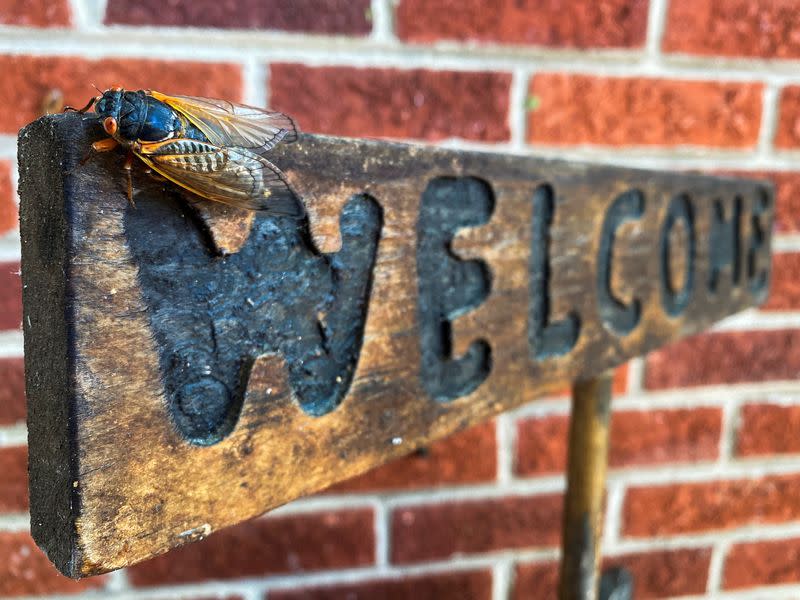Explainer-When the double brood of cicadas will come out - and what to expect
By Will Dunham
WASHINGTON (Reuters) -Parts of the United States are about to experience a rare natural phenomenon with the simultaneous emergence of two enormous adjacent broods of periodical cicadas. More than a trillion of these noisy bugs are set to pop out of the ground starting around late April.
The two broods - one concentrated in U.S. Midwestern states and the other in the South and Midwest, with a small area of overlap in Illinois - emerge together only once every 221 years.
Here is an explanation of what is expected to occur during this "dual emergence."
WHAT IS A CICADA?
Cicadas are relatively large insects - 1-2 inches (2.5-5 cm) long - possessing sturdy bodies, bulging compound eyes and membranous wings. There are many different kinds of cicadas.
Using needle-like mouthparts, cicadas feed on plant juices, called xylem, drawn from the roots of deciduous trees and shrubs. They spend much of their life cycle - years on end - underground as nymphs feeding on roots and drinking xylem.
After they emerge, adult males "sing" to attract females using special organs called tymbals on the first segment of the abdomen. The song pitch, tone, frequency and volume are specific to individual species. Cicadas live as adults for just a few weeks, then die after reproducing. Numerous birds and mammals eat cicadas.
HOW DO PERIODICAL AND ANNUAL CICADAS DIFFER?
With annual cicadas, some individuals emerge during any given year. They spend one to nine years underground as nymphs, varying by species, and do not have a synchronized emergence. Instead, they emerge on a staggered basis.
Periodical cicadas have more specific and longer lengths of time spent underground as nymphs - generally 13 years or 17 years - and a synchronized emergence. That means that all members of a particular brood emerge the same year, from late April into June, depending on their location. All of the periodical cicadas sharing the same life cycle that emerge together in a given year are called a brood, although any one species may be part of different broods.
There are more than 3,000 species of cicadas worldwide, but only nine are periodical, and seven of those - of the genus Magicicada - are found in North America. In India, a periodical species of the genus Chremistica emerges every four years, while in Fiji, a periodical species of the genus Raiataena emerges every eight years.
WHAT TWO BROODS ARE INVOLVED IN THIS YEAR'S DUAL EMERGENCE?
Brood XIII, on a 17-year cycle, is restricted mostly to northern Illinois, eastern Iowa, southern Wisconsin and a few counties in extreme northwestern Indiana, according to entomologist Floyd Shockley of the Smithsonian Institution's National Museum of Natural History in Washington. Brood XIII includes three Magicicada species.
Brood XIX, on a 13-year cycle, is widely distributed from Alabama, Arkansas, Georgia, Indiana, Illinois, Kentucky, Louisiana, Maryland, Missouri, Mississippi, North Carolina, Oklahoma, South Carolina, Tennessee and Virginia - a total of 15 states, according to Shockley. Brood XIX includes four Magicicada species.
These two broods together span parts of 17 states but overlap only in a small area in central Illinois. They are close enough potentially to have some interbreeding between broods.
WHEN WILL THIS DUAL EMERGENCE OCCUR?
Periodical cicadas are expected to begin emerging in the southern parts of their geographical distribution in mid-April. The emergence continues northward into June. Given that most broods produce localized population numbers exceeding 1.5 million cicadas per acre (0.4 hectare) in densely populated areas of their distribution, there easily will be more than a trillion cicadas during this emergence, according to Shockley.
WHEN WAS THE LAST SUCH 'DUAL EMERGENCE'?
This will mark the first time that a 13-year brood emerges in the same year as a 17-year brood since 2015. The last time that adjacent 13-and 17-year broods emerged in the same year was 1998, according to University of Connecticut evolutionary biologist John Cooley. Brood XIX, one of the two popping out this year, emerged in 1998 at the same time as Brood IV, which spans Iowa, Kansas, Missouri, Nebraska, Oklahoma and Texas.
The next time two 13-and 17-year broods will emerge the same year will not be until 2037 and the next time adjacent 13-and 17-year broods emerge together will not be until 2076, Cooley said.
WHAT DO CICADAS DO WHEN THEY EMERGE?
The cicadas begin emerging, mainly at night, once the soil warms to about 64 degrees Fahrenheit (17.8 degrees C), according to George Washington University entomologist John Lill. These nymphs crawl up any hard surfaces - tree trunks, fences, vegetation - and molt into adult winged cicadas.
After a few days, adults fly into the tree canopy, where males form loud "choruses," calling to females by vibrating their tymbals. Males have rather hollow abdomens, serving as echo chambers to amplify their calls. Cicadas are among the loudest insects. Females that are attracted to a particular male's call respond with wing flicks, which also make a sound. Pairs then mate.
Once mated, female cicadas seek pencil-sized branches of trees and shrubs in sunny locations to lay their eggs into slits they cut in branches, according to Lill. These eggs develop for about six to seven weeks, after which hatched nymphs drop to the ground and burrow to begin the next generation of periodical cicadas.
WHEN WILL THIS BUG-TASTIC EVENT OCCUR NEXT?
These two broods last emerged in the same year in 1803. The next time is set for 2245.
(Reporting by Will Dunham in Washington, Editing by Rosalba O'Brien)


